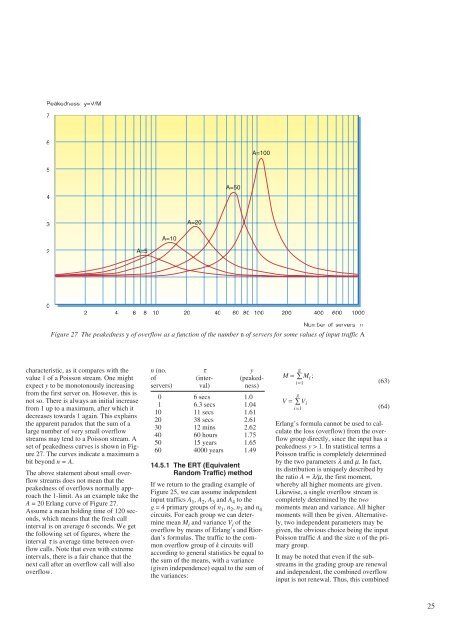Contents Telektronikk - Telenor
Contents Telektronikk - Telenor
Contents Telektronikk - Telenor
You also want an ePaper? Increase the reach of your titles
YUMPU automatically turns print PDFs into web optimized ePapers that Google loves.
Peakedness: y=V/M<br />
7<br />
6<br />
5<br />
4<br />
3<br />
2<br />
1<br />
characteristic, as it compares with the<br />
value 1 of a Poisson stream. One might<br />
expect y to be monotonously increasing<br />
from the first server on. However, this is<br />
not so. There is always an initial increase<br />
from 1 up to a maximum, after which it<br />
decreases towards 1 again. This explains<br />
the apparent paradox that the sum of a<br />
large number of very small overflow<br />
streams may tend to a Poisson stream. A<br />
set of peakedness curves is shown in Figure<br />
27. The curves indicate a maximum a<br />
bit beyond n = A.<br />
The above statement about small overflow<br />
streams does not mean that the<br />
peakedness of overflows normally approach<br />
the 1-limit. As an example take the<br />
A = 20 Erlang curve of Figure 27.<br />
Assume a mean holding time of 120 seconds,<br />
which means that the fresh call<br />
interval is on average 6 seconds. We get<br />
the following set of figures, where the<br />
interval τ is average time between overflow<br />
calls. Note that even with extreme<br />
intervals, there is a fair chance that the<br />
next call after an overflow call will also<br />
overflow.<br />
A=5<br />
A=10<br />
A=20<br />
0<br />
1 2 4 6 8 10 20 40 60 80 100 200 400 600 1000<br />
Number of servers n<br />
Figure 27 The peakedness y of overflow as a function of the number n of servers for some values of input traffic A<br />
A=50<br />
A=100<br />
n (no. τ y<br />
of (inter- (peakedservers)<br />
val) ness)<br />
0 6 secs 1.0<br />
1 6.3 secs 1.04<br />
10 11 secs 1.61<br />
20 38 secs 2.61<br />
30 12 mins 2.62<br />
40 60 hours 1.75<br />
50 15 years 1.65<br />
60 4000 years 1.49<br />
14.5.1 The ERT (Equivalent<br />
Random Traffic) method<br />
If we return to the grading example of<br />
Figure 25, we can assume independent<br />
input traffics A1 , A2 , A3 and A4 to the<br />
g = 4 primary groups of n1 , n2 , n3 and n4 circuits. For each group we can determine<br />
mean Mi and variance Vi of the<br />
overflow by means of Erlang’s and Riordan’s<br />
formulas. The traffic to the common<br />
overflow group of k circuits will<br />
according to general statistics be equal to<br />
the sum of the means, with a variance<br />
(given independence) equal to the sum of<br />
the variances:<br />
g<br />
M = ∑ Mi ;<br />
i=1<br />
g<br />
V = ∑Vi<br />
i=1<br />
(63)<br />
(64)<br />
Erlang’s formula cannot be used to calculate<br />
the loss (overflow) from the overflow<br />
group directly, since the input has a<br />
peakedness y > 1. In statistical terms a<br />
Poisson traffic is completely determined<br />
by the two parameters λ and µ. In fact,<br />
its distribution is uniquely described by<br />
the ratio A = λ/µ, the first moment,<br />
whereby all higher moments are given.<br />
Likewise, a single overflow stream is<br />
completely determined by the two<br />
moments mean and variance. All higher<br />
moments will then be given. Alternatively,<br />
two independent parameters may be<br />
given, the obvious choice being the input<br />
Poisson traffic A and the size n of the primary<br />
group.<br />
It may be noted that even if the substreams<br />
in the grading group are renewal<br />
and independent, the combined overflow<br />
input is not renewal. Thus, this combined<br />
25

















